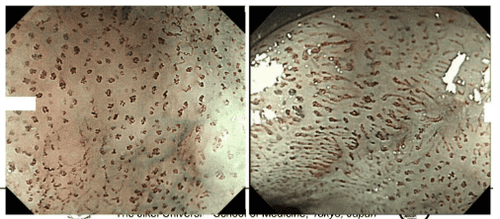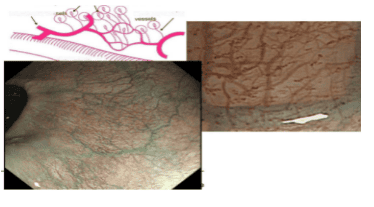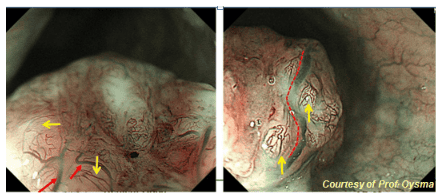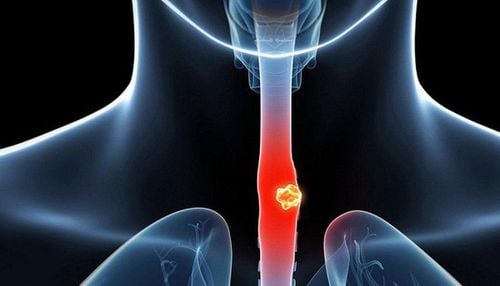This is an automatically translated article.
Post by Master, Doctor Mai Vien Phuong - Department of Examination & Internal Medicine - Vinmec Central Park International General Hospital
Currently, functional magnifying endoscopic staining has become the first-choice clinical method for the early diagnosis of esophageal squamous cell carcinoma. However, the accuracy of functional magnified staining endoscopic function in the early diagnosis of esophageal squamous cell carcinoma is limited by the experience and qualifications of the endoscopist. Artificial intelligence can help inexperienced endoscopists intelligently analyze medical images, detect and/or classify lesions, and improve diagnostic accuracy using advanced algorithms. variation math.
1. Artificial intelligence can help diagnose early or invasive esophageal cancer
It can distinguish superficial esophageal cancer from invasive advanced cancer with 98% accuracy. Then, Cai et al proposed a new computer-aided diagnostic system (CAD) using deep neural network (DNN). Two thousand four hundred and twenty-eight (1332 abnormal images, 1096 normal images) from 746 patients were collected to establish a new two-centre DNN-CAD system and a validation dataset of 187 images from 52 patients were prepared. Only standard WLIs are used to train the model. The DNN-CAD model was able to detect 91.4% of early esophageal squamous cell carcinoma, higher than the advanced endoscopic model. Ohmori et al evaluated magnified endoscopic and non-endoscopic images [including WLI and NBI/Blue Laser Imaging (BLI)] using a CNN-based Single-Shot Multibox Detector (SSD) to identification of esophageal squamous cell carcinoma. The accuracy of magnifying endoscopy, non-magnifying endoscopy + WLI and non-magnifying endoscopy + NBI/BLI were high SEN and moderate SPE, 77%, 81% and 77%, respectively.
2. Diagnostic performance between artificial intelligence and experienced endoscopists
Research has demonstrated that there is no significant difference in diagnostic performance between artificial intelligence and experienced endoscopists. Diagnostic endoscopy Zhao et al conducted another CAD model to evaluate the feasibility of automatic classification of intramucosal capillary rings to improve the detection of esophageal squamous cell carcinoma. . Magnified endoscopic images - NBIs were collected and a double-labeled full complex network was developed for image segmentation. In the study, it was shown that the diagnostic accuracy of senior observers was much higher than that of middle and junior observers. When this model differentiated intramucosal capillary ring A, B1 and B2 lesions, the accuracy rate of lesion level and pixel diagnosis reached 89.2% and 93%, respectively. like the seniors. Specifically, the model was more sensitive to the intramucosal capillary ring of type A than clinicians (71.5% vs 28.2%-64.9%), possibly avoiding unnecessary radical treatment. A total of 7046 sequential NBI-magnified endoscopic HD images from 17 patients were used for CNN training in another study conducted by Everson et al. Intramucosal capillary ring samples were also classified according to the JES classification. This CNN distinguishes anomalies from normal intramucosal capillary ring patterns with 93.7% accuracy.

The endoscope system provides a magnified endoscope that can be stained with methylene blue for visualization of superficial epithelial cells. The optical magnification of esophageal cancer S is 500 ×, which can be increased to 900 × using digital magnification in the video processor. Kumagai et al used a CNN-based artificial intelligence system based on GoogLeNet and trained using 4715 esophageal cancer S images of the esophagus (1141 malignant and 3574 non-malignant images). for the diagnosis of esophageal squamous cell carcinoma by imaging of esophageal cancer S. An independent set of 1520 images, collected from 55 consecutive patients (27 esophageal squamous cell carcinoma and 28 benign esophageal lesions) were tested. Artificial intelligence correctly diagnosed 25 of 27 esophageal squamous cell carcinomas with an overall SEN of 92.6%, an SPE of 89.3%, and an overall accuracy of 90.9%.
4. Accuracy of artificial intelligence in diagnosing invasiveness of esophageal cancer
The diagnosis of invasive squamous cell carcinoma of the oesophagus was performed by Nakagawa et al., not to identify the intramucosal capillary ring pattern, but to predict the depth of cancer invasion by using using a deep learning technology system based on the CNN-SSD architecture. For all magnified non-endoscopic and endoscopic images, the system's ability to accurately differentiate mucosal/submucosal microinvasive (EP/SM1) from deeply invasive cancers submucosal (SM2/3) were 91%, 92.9%, and 89.7%, respectively, with performance comparable to experienced endoscopists.
In the study by Tokai et al., the ability of artificial intelligence to measure the depth of esophageal squamous cell carcinoma invasion was demonstrated. They collected 1751 esophageal squamous cell carcinoma training images obtained by WLI and NBI from the Japan Cancer Institute Hospital and developed the CNN-SSD diagnostic system. The obtained magnified images were excluded. Then, 291 laboratory images from 55 patients confirmed by pathological findings were used to compare the artificial intelligence system with 13 board-certified endoscopists. The artificial intelligence system detected 95.5% of esophageal squamous cell carcinomas in the test images in 10 seconds and accurately estimated the depth of invasion of esophageal squamous cell carcinomas. in 6 seconds, with a SEN of 84.1% and an accuracy of 80.9%. The accuracy score of this system exceeded 12 out of 13 endoscopists, and its AUC was greater than the AUC of all endoscopists. It is shown that the artificial intelligence system has the potential to be used to diagnose esophageal squamous cell carcinoma and measure the depth of invasion.

Please dial HOTLINE for more information or register for an appointment HERE. Download MyVinmec app to make appointments faster and to manage your bookings easily.
ReferenceLiu Y. Artificial intelligence-assisted endoscopic detection of esophageal neoplasia in early stage: The next step? World J Gastroenterol 2021; 27(14): 1392-1405 [DOI: 10.3748/wjg.v27.i14.1392]. Thrumurthy SG, Chaudry MA, Thrumurthy SSD, Mughal M. Esophageal cancer: risks, prevention and diagnosis. BMJ . Year 2019; 366: l4373. [ PubMed ] [ DOI ] Merkow RP , Bilimoria KY, Keswani RN, Chung J, Sherman KL, Knab LM, Posner MC, Bentrem DJ. Treatment trends, risk of lymph node metastasis and outcome of localized esophageal cancer. J Natl Cancer Inst . 2014; 106 . [ PubMed ] [ DOI ] Liu Y. Artificial intelligence-assisted endoscopic detection of esophageal neoplasia in early stage: The next step? World J Gastroenterol 2021; 27(14): 1392-1405 [DOI: 10.3748/wjg.v27.i14.1392]














